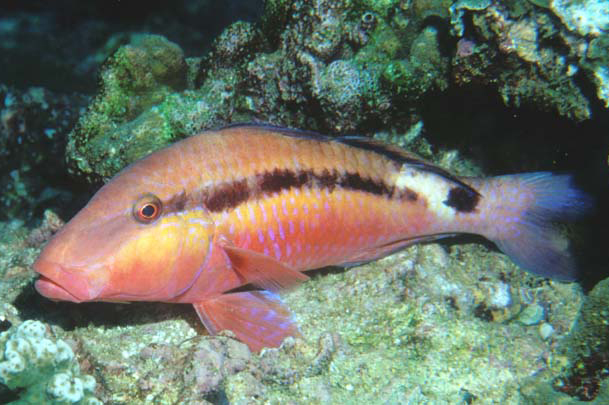- Classification
- ACTINOPTERYGII
- PERCIFORMES
- MULLIDAE
- Parupeneus
- macronemus
Longbarbel Goatfish, Parupeneus macronemus (Lacépède 1801)
Other Names: Long-barbel Goatfish

A Longbarbel Goatfish, Parupeneus macronemus, in the Gulf of Oman, at Fahl Island, Oman. Source: Richard Field / FishBase. License: All rights reserved
Summary:
A whitish to greyish, or pinkish to reddish goatfish with long sensory chin barbels, a broad black stripe from the eye running along the lateral line to below the soft dorsal fin, a large black spot (greater than eye diameter) on the middle of the caudal peduncle preceded by a broad white area, and a broad dark stripe along the base of the second dorsal fin. Individuals may become pinkish to reddish at night.
Cite this page as:
Bray, D.J. 2020, Parupeneus macronemus in Fishes of Australia, accessed 27 Jun 2025, https://fishesofaustralia.net.au/Home/species/4940
Longbarbel Goatfish, Parupeneus macronemus (Lacépède 1801)
More Info
|
Distribution |
Recorded in the Australian EEZ from the territories of Christmas Island and Cocos (Keeling) Islands in the Indian Ocean. Elsewhere the species occurs in the tropical Indo-West Pacific. Individuals or small inhabit sandy, rubble and weedy areas at depths to 40 m. |
|
Features |
Dorsal fin VIII + 9; Anal fin I, 7; Pectoral fin 15-17 (usually 16); Gill rakers 7-9 + 27-30 (total 34-39). Body moderately elongate, the depth 3.3-3.7 in SL; head length (HL) 2.8-3.2 in SL; snout length 1.7-1.9 in HL; barbels long, their length 1.1-1.25 in HL; longest dorsal spine 1.45-1.75in HL; penultimate ray of second dorsal fin of adults 1.25-1.6 in last dorsal ray, the last ray relatively longer with growth; pectoral fins 1.3-1.5 in HL; pelvic fins 1.2-1.45 in HL. |
|
Colour |
Body grey to greyish-red above, whitish to pink below, with a black stripe from eye along lateral line to anterior part of caudal peduncle; a roundish black spot larger than eye on side of peduncle about two-thirds above lateral line; a broad white area from in front of the peduncular spot to below the rear of the second dorsal fin; scales below black stripe often with a pale blue vertical line or spot; a dusky band often present on snout from eye to side of upper lip; barbels white; first dorsal and caudal fins reddish-grey; basal one-third to one-half of second dorsal fin black, the dark pigment continuing to end of last ray and adjacent membrane; outer part of fin with narrow pale blue and yellow stripes; anal fin dusky yellow with faint narrow pale blue stripes. |
|
Feeding |
Feeds by probing the sediment with its long barbels in search of prey such as crustaceans and polychaete worms. |
|
Fisheries |
Fished commercially in parts of its range; also traded in the aquarium industry. |
|
Similar Species |
The similar Dot-and-dash Goatfish, Parupeneus barberinus, has a narrower black stripe along the side, and lacks the blackish stripe along the second dorsal-fin base. |
|
Etymology |
The specific name macronemus is from the Greek macro (= long) and nema (= thread), in reference to the long chin barbels of this species. |
|
Species Citation |
Mullus macronemus Lacepède, 1801, Hist. Nat. Poiss 3: 404, pl. 13 (fig. 2). No type locality specified. |
|
Author |
Bray, D.J. 2020 |
|
Resources |
Longbarbel Goatfish, Parupeneus macronemus (Lacépède 1801)
References
Allen, G.R. 1997. Marine Fishes of Tropical Australia and South-east Asia. Perth : Western Australian Museum 292 pp. 106 pls.
Allen, G.R. & Erdmann, M.V. 2012.Reef fishes of the East Indies. Perth : Tropical Reef Research 3 vols, 1260 pp.
Allen, G.R. & Smith-Vaniz, W.F. 1994. Fishes of Cocos (Keeling) Islands. Atoll Research Bulletin 412: 1-21.
Allen, G.R., Steene, R.C. & Orchard, M. 2007. Fishes of Christmas Island.Christmas Island : Christmas Island Natural History Association 2 edn, 284 pp.
Bleeker, P. 1875. Révision des espèces insulindiennes de la famille des Mulloïdes. Verhandelingen der Koninklijke Akademie van Wetenschappen 15: 1-40.
Hobbs, J-P.A., Newman, S.J., Mitsopoulos, G.E.A., Travers, M.J., Skepper, C.L., Gilligan, J.J., Allen, G.R., Choat, H.J. & Ayling, A.M. 2014. Checklist and new records of Christmas Island fishes: the influence of isolation, biogeography and habitat availability on species abundance and community composition. Raffles Bulletin of Zoology Supplement 30: 184–202 https://lkcnhm.nus.edu.sg/rbz/supplement-no-30/
Hobbs, J-P.A., Newman, S .J., Mitsopoulos, G.E.A., Travers, M.J., Skepper, C.L., Gilligan, J.J., Allen, G.R., Choat, H.J. & Ayling, A.M. 2014. Fishes of the Cocos (Keeling) Islands: new records, community composition and biogeographic significance. Raffles Bulletin of Zoology Supplement 30: 203–219 https://lkcnhm.nus.edu.sg/rbz/supplement-no-30/
Lacepède, B.G. 1801. Histoire Naturelle des Poissons. Paris : chez Plassan Vol. 3 558 pp. 34 pls. See ref at BHL
Randall, J.E. 2001. Mullidae. pp. 3175-3200 in Carpenter, K.E. & Niem, V.H. (eds). The Living Marine Resources of the Western Central Pacific. FAO Species Identification Guide for Fisheries Purposes. Rome : FAO Vol. 5 2791-3379 pp.
Randall, J.E. 2004. Revision of the goatfish genus Parupeneus (Perciformes: Mullidae), with descriptions of two new species. Indo-Pacific Fishes 36: 1-64 pls 1-16
Smith-Vaniz, W.F. & Williams, I. 2016. Parupeneus macronemus (errata version published in 2017). The IUCN Red List of Threatened Species 2016: e.T46086601A115393911. https://dx.doi.org/10.2305/IUCN.UK.2016-3.RLTS.T46086601A46664729.en. Downloaded on 22 August 2020.





